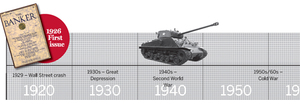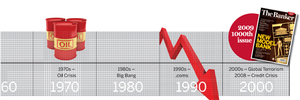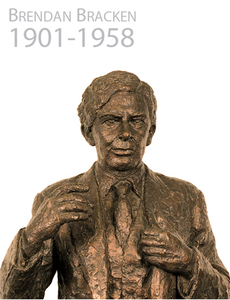Its longevity is as unique as its global appeal and from its very first issue to this, its 1000th, The Banker has remained true to the vision set out by its founder, Brendan Bracken. The international outlook and forward thinking that has made The Banker such a success over the past 83 years is a course that will be steadfastly continued. Writer Stephen Timewell
This is the 1000th issue of The Banker, the monthly magazine that continues to be the world's foremost source of global financial intelligence as it has been for more than eight decades since its foundation in January 1926. The Banker is unique in that it not only provides global perspectives on all aspects of the banking industry across all continents, but it maintains the global vision of its founding editor, Brendan Bracken, who later became chairman of the modern Financial Times from 1945-58.
Few monthlies ever achieve 1000 issues, although Reader's Digest reached this landmark in 2005, and few, if any, have the breadth and influence of The Banker brand. The magazine is read in more than 180 countries and in the latest Global Capital Markets readership survey it was listed as the leading monthly in the world.
The current global financial crisis has drawn enormous comment and many have called it the greatest upheaval since the Great Depression in the 1930s. The Banker's early issues covered the build-up to events in 1929 and beyond.
International perspective
The hallmark of its style back then, as it is today, is the international character of the magazine and that is amply demonstrated in the first issue in January 1926. Here the chairman of Anglo-South American Bank analysed banking developments in South America, Sir Sidney Sitwell assessed the various classes of banks in India, and Joseph Caillaux, the former prime minister and finance minister of France (who later became The Banker's regular Paris correspondent) waxed eloquent on the financial situation in France in not only English but French as well. And this was on top of a unique profile of Montagu Norman, governor of the Bank of England, by former UK chancellor of the exchequer Sir Robert Horne. And all for the price of one shilling.
High-calibre commentary
From its inception, The Banker was distinguished by the quality of its contributors and this continues to this day. In March 1926, one of the century's foremost economists, John Maynard Keynes, profiled the 19th century economic sage Walter Bagehot, noting: "It was Bagehot who first insisted that by force of circumstances, whether we like it or not, the Bank of England had become a national institution with national responsibilities, and could no longer function with primary regard to the profits of its shareholders." At that time, Italian finance minister Count Volpi wrote on 'The Achievements of Fascism'. Later that year, Harold Macmillan, who became UK prime minister in the 1950s, commented on local government finance and in May 1928, author HG Wells wrote about the money credit system.
The focus for The Banker was and is on providing global banking perspectives and this is clearly shown in an article 'Internationalisation of Banking' by Paul Einzig in June 1929. "The internationalisation of banking is decidedly advantageous from every point of view.... The establishment of innumerable financial links between countries will contribute to make people realise that it is impossible to hurt our neighbours without hurting ourselves. While, before the [First World War], international finance was confined to the select few, at present it is becoming more and more popular in character. It is difficult to imagine more democratic institutions than commercial banks, with hundreds of thousands of depositors and shareholders. The increased interest of these institutions in foreign banking is a notable forward step in the application of the fundamental principle of democracy to international finance."
In its 100th issue in May 1934, The Banker addressed banking in the US, France and Germany along with issues over speculation in exchanges. "The question is whether it would be wise to eliminate speculation even if it were possible to do so. The existence of a reasonable amount of speculative activity is a necessary evil under existing conditions, and, on balance, legitimate trade stands to benefit by it."
Epochal coverage
The Banker published uninterrupted throughout the Second World War and in the post-war period its articles included Paul Einzig's 'Economic Peace in our Time', J Grahame-Parker's 'The Nationalisation of the French Banking System', and, of course, coverage of the establishment of the Bretton Woods twins (the International Monetary Fund and the World Bank).
In its 300th issue, in January 1951, The Banker addressed 'South Africa's Recovery' and 'Israel's Development Problems' along with 'Britain's Aid to the Commonwealth'. In the following years it covered the era of post-war economic expansion and the beginning of big bank mergers in the US.
Nineteen seventy was a landmark year for The Banker, with the first-ever annual worldwide ranking of banks, then covering only 300 banks and based on asset size. Bank of America led the Top 300 in our 532nd issue in June, with assets of $25.6bn. Today The Banker's Top 1000 World Banks listing and related country and regional listings represent the definitive source of global bank data.
Contemporary concerns
In an increasingly globalised world, The Banker's global listings and global commentary have become ever more important. Reflecting on technology, change and banking, Bill Gates, chairman of Microsoft, noted in our 839th issue in January 1996: "The status quo in almost any sphere is usually reticent to embrace change, but a glance through the 70 years of reporting within The Banker should offer comfort. It shows an industry that is robust and adaptable - and, unlike the dinosaurs, well positioned to benefit from evolution." One wonders whether that industry view still applies today?
In our 895th issue, in September 2000, The Banker introduced its banking awards for commercial and investment banks. Citigroup was the inaugural Global Bank of the Year when awards were given in 83 countries but by our 994th issue in December last year awards were given in a record 148 countries.
Our 989th issue in July last year showed the aggregate pre-tax profits of the Top 1000 World Banks declined for the first time in seven years, slipping by 0.7% to $780.8bn. These results do not reflect last year's global financial meltdown, which will be dramatically seen in next month's Top 1000 results in our 1001st issue.
The Banker has been witness, analyst and commentator on the momentous global financial events of the past eight decades. Our 1000th issue comes at perhaps the most difficult time ever experienced by banks across the globe, a time when better financial intelligence is absolutely critical to success. The Banker believes Brendan Bracken's international vision for the magazine is just as important in today's turmoil as it was before the Great Depression and as it will be in the undoubted future financial crises to come.
Brendan Bracken
Brendan Bracken was not just the founding editor of The Banker in 1926, he also had a distinguished publishing and political career. From a humble Irish background he discovered that banking was the only trade or profession without its own specialist publication and thereupon founded and edited The Banker from 1926-37. He latterly became a close confidant of Winston Churchill and minister of information during the Second World War. He then acquired and became chairman of the modern Financial Times from 1945-58 and went on to attain a peerage as Viscount Bracken.
Upon his death in 1958, The Banker paid tribute: "He was its founder and its first editor, and over the 30 years of full blossoming of his rich personality and his wide ranging interests, he yet remained its chairman, its counsellor and its friend. It was for him a starting point, a first success that led him on to his first resounding one, the formation two years later of the group that acquired, in addition, The Financial News, the Investors Chronicle and a half interest in The Economist - a group that reached out in 1945 to embrace The Financial Times and to merge the two dailies under that banner."
Brendan Bracken's vision of a truly global banking publication, concentrating on international rather than domestic UK issues, has continued to this day. His memory is honoured in the magazine through the Bracken column and via The Banker's pre-eminent awards, which see winners receiving a bust of the founder.






